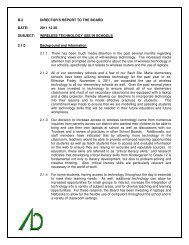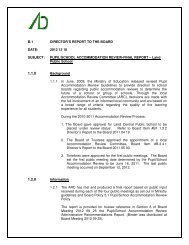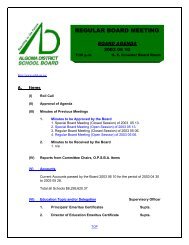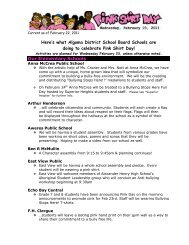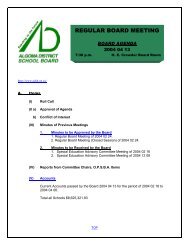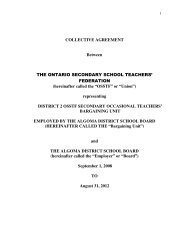Educating Our Educators Guide for Staff - Algoma District School ...
Educating Our Educators Guide for Staff - Algoma District School ...
Educating Our Educators Guide for Staff - Algoma District School ...
- No tags were found...
You also want an ePaper? Increase the reach of your titles
YUMPU automatically turns print PDFs into web optimized ePapers that Google loves.
Other practical knowledge base originating from the Aboriginal people include: Upset stomach remedies: a tea made with the entire blackberry plant was used <strong>for</strong> a number ofsicknesses, such as upset stomach. Eating the actual berry or drinking its juice was also an effectiveway to control diarrhea. Corn – corn is a staple food that was cultivated by Aboriginal people <strong>for</strong> thousands of years. Today,corn is a vital, hardy and high-yielding plant that can grow practically anywhere in the world. Petroleum Jelly – Aboriginal people discovered petroleum jelly and used it to moisten and protecthuman and animal skin. This skin ointment is one of the most popular in the world today. Wild Rice – wild rice is actually a delicious and prized cereal grain. It was misnamed by Europeannewcomers because of its rice-like appearance. Some Aboriginal people presented wild rice astreasured gifts to fur traders as a symbol of friendship. Cough Syrup – many Aboriginal people throughout Canada developed unique combinations of wildplants to relieve coughs due to colds. The same ingredients are found in many cough medicinessold today. The balsam of various pine trees, maple syrup, or honey, are mixed with teas made fromhealing plants to produce very effective cough medicines. Chewing Gum – Aboriginal people discovered the first chewing gum, which was collected fromspruce trees. In the 1800’s, sugar was added, and chewing gum has since become popularthroughout the world. Pain Relief – the active ingredient in today’s most commonly used pain reliever was known toAboriginal people in North America <strong>for</strong> centuries. Pain relievers such as Aspirin use an acid, which isfound in 15 to 20 different species of the willow tree, including the pussy willow.<strong>Educating</strong> <strong>Our</strong> <strong>Educators</strong> – <strong>Educating</strong> <strong>Our</strong> Aboriginal StudentsRevised March 201124



